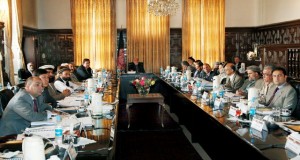I’ll probably have a few posts on Harold Koh’s speech opposing what he calls the “Forever War” at the Oxford Union. For now, I want to look at his argument against a new Authorization to Use Military Force.
I strongly disagree with those who claim that new legislation is now necessary to authorize the Administration to fight against new enemies. The burden of proving that such legislation would be either necessary or wise should fall on the proponents. As a lifelong international and constitutional lawyer who has worked on these legal issues for a decade, I see no proof that the U.S. lacks legal authority to defend itself against those with whom we are genuinely at war or who pose to us a genuine and imminent threat. Significantly, Congress has never declared war against an enemy when the President has not asked for such a declaration. Nor would adopting new domestic legislation make actions in preemptive self-defense lawful under international law. And unless we can clearly define just who the new enemies are–and why existing legal authorities are insufficient to defend ourselves against them–we have no basis for passing new laws that would perpetuate the Forever War against shadowy foes whose association with those who have attacked us on 9/11 cannot be proven.
It’s hard to tell where the boundaries between good faith and deception lie here. After all, in several places in the speech — including this passage purportedly distinguishing what Obama has done from what Bush did — Koh’s language admits the possibility that Congressional sanction for military force is not the only authority Obama is working with (though he does admit that Congressional authority is one source of authority).
First, the Obama Administration has not treated the post-9/11 conflict as a Global War on Terror to which no law applies, in which the United States is authorized to use force anywhere, against anyone. Instead, it has acknowledged that its authority under domestic law derives from Acts of Congress, not just the President’s s vague constitutional powers.
And so when he says things like “I see no proof that the U.S. lacks legal authority to defend itself against those with whom we are genuinely at war or who pose to us a genuine and imminent threat,” it seems likely he’s preserving the ability to rely on Article II authority for something called an “imminent threat.” The same is true when he invokes “existing legal authorities” when he talks about fighting people who are clearly not Al Qaeda.
In other words, even while he seems to be opposed to treating our newer enemies as war opponents, he also seems to be reserving the right to rely on Article II authority to go after them. Which is not necessarily a better proposition for those who truly value other tools rather than killing.
That’s why I’m struck by this sentence.
Significantly, Congress has never declared war against an enemy when the President has not asked for such a declaration.
What Koh seems to be worried about is shifting the balance of the Youngstown test — whether Presidential power is expansive or limited — of the AUMF itself (Koh pretends authorizing military force is the same thing as declaring war, but in any case, last I checked, the authority to declare war belonged to Article I).
That’s true, first of all, because the way the existing AUMF was written — which allows the President to determine the enemy and has been interpreted consistently but wrongly as authorizing war powers here in the US. A new AUMF might (though probably wouldn’t) explicitly clarify the limits to war powers in the US or at least with US citizens.
But as even the 2012 NDAA showed, it can work the other way, with Congress requiring that Obama default to military detention and commissions with any new terrorist suspects. Mind you, Obama took the limits on what he could do in Gitmo far, far more seriously than he did the requirement that DOD give every one of its detainees a meaningful review, so he’s already picking and choosing what legislative requirements he fulfills. But in theory at least, Congress can mandate the President treat certain targets as enemies of war, rather than criminals.
But that, it seems to me, is ultimately what this debate about a new AUMF comes down to. Koh and, presumably, others who have served the President won’t want Congress to change the delicate balance that offers the President a great deal of flexibility to operate under both the AUMF and Article II. And to some degree, they’re right to worry about what batshit stuff the Lindsey Grahams of the world will mandate. But I suspect they’re just as worried that a new AUMF will put real limits to the President’s current fairly unlimited authority.
Look, I don’t trust Congress to write a new AUMF either. If they do one, it’s going to contain all manner of batshittery.
But bizarrely, in our crazy world, passing a new one might actually be a more effective way to limit what the President can and can’t do as anything else that has been tried. If we want to force the Executive Branch to stop waging war against Americans in America, we’re going to have to do so explicitly.

